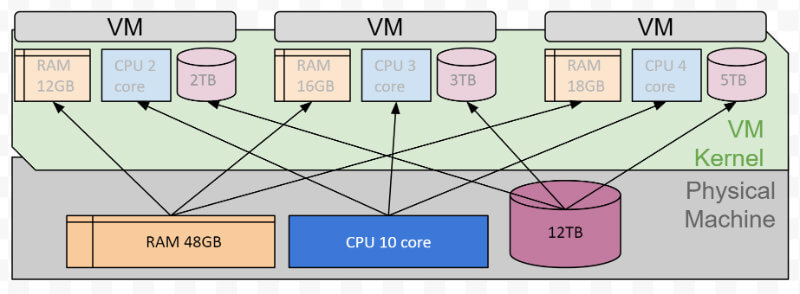We are more and more asked about VM (Virtual Machines). There are numerous advantages of VM over physical servers and there is a lot of buzz and many broadcasters are asking us to provide proposals based on VMs. But there are also some Myths involved. In some cases VMs do not benefit from its advantages such as in broadcast logging and repurposing applications, although VM can be used.
Physical servers are what we have been using for broadcast compliance since years. These are like over-sized PCs, designed for heavy-duty operation, with a large number of hard disks, power supplies, CPUs and RAM. They also operate under a “Server” O/S which is more robust than the consumer grade system.
Virtual machines exist when a pool of computer resources are divided among a number of systems (operating systems, or specialized software) that “act” as if each of them was a complete computer server.
Each acting system is a VM, and one may also use the term “Hypervisor”. This means that any software running on that VM “thinks” that it is running on a full server, when in fact the resources are coming from various computer assets that are put together.
Advantages of Virtual Machine
This brings us to the first real advantage of VM. One physical server can in theory host dozens of hypervisors/VM, and each of these VMs will run a different application, thus replacing the need for dozens of separate, dedicated, and underutilized PCs. Such a system will work perfectly on the condition that not all users/applications require the full ressources at the same time.
Another obvious advantage of VM is the easier management. In case of failure or even re-configuration, rebuilding a physical (hardware) server is a difficult task. Re-configuring a VM is a simple software configuration.
Finally, the scalability of VM is a breeze. In our context, adding one additional TV channels encoder and a recorder, can practically be done without any physical intervention (no need to add disk, memory, CPU..) and all by configuration.
To summarize, the 3 main advantages of VM are:
Virtual Machine |
Physical Server |
|
CAPEX Investment |
|
|
System Management |
|
|
Scalability and Flexibility |
|
|
With all these advantages, there is bound to be some disadvantages too.
Disadvantages of Virtual Machine
A VM would always be less powerful than a comparable physical machine. If we install a VM on a server that has say 10 cores and 48GB RAM, and use it in full capacity (mining for Bitcoins for example…) then we notice that it would deliver around 10% less (and sometimes up to 20%) CPU power than the number of cores physically available. The difference is explained by the layer of overhead that is constantly allocating virtual resources to the applications.
Another cost is the price of the VM system itself. VM software licenses are sold at high prices, several thousands US$ per server license. The high price is perhaps justified when the VM is used by dozens of users and saving much hardware, but it is a net burden when the VM and the Physical machine are both used at full capacity.
So the VM disadvantages are:
Virtual Machine |
Physical Server |
|
CPU Power |
||
O/S cost |
VM and physical servers have different advantages and disadvantages.
Based on these, we can recommend VMs for applications that are:
- Running a large number of services, or users
- Each service is variable in terms of CPU requirements (sometimes high, often low)
- There are many changes, new applications are added, sizing is often modified.
- For example Web servers, serving thousands of users, are very appropriate for VMs.
It is probable that in the near future, for the majority of all server applications, the VM will be a better choice.
On the other hand, physical servers give benefits when:
- The number of services is constant
- Each of the services requires constant resources.
- It is possible to size a server to use close to 100% of its capacity, constantly.
- Very few changes over time.
In the context of Media encoding servers, where we have customers encoding video from a number of specific TV channels, the amount of CPU used is constant, as are the number of channels, as well as the retention period and the video quality. This means that it is possible to size the servers at almost full capacity. In this context, a physical server is a better choice.
⏩ A physical server will deliver 10% to 20% more than VM and will cost 10% to 20% less.




